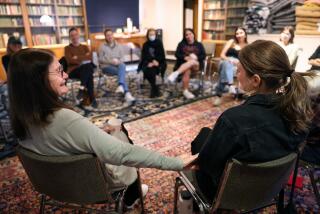Teacher Can’t Help Students With Life’s Hardest Lesson: Death : Washington: Stephanie Hill had enchanted Lafeyette Elementary School. When she was killed in a car crash, the grief was devastating.
- Share via
WASHINGTON — Her name was Stephanie Hill, and she had 21 children--a devoted class of second-graders at Lafayette Elementary School. In an instant she was gone, killed in a car crash. The children had to learn their hardest lesson without her.
The school’s unique sense of security was smashed, like the car that Hill was driving. She wasn’t sick, she wasn’t old. But still she died.
“Why?” sobbed my 7-year-old daughter, Rebecca. “Why couldn’t somebody mean die instead? It’s not fair.”
“It’s not fair,” I agreed. I tried to comfort her, unable to hold back my own tears.
The new school year had held such promise. After nurturing Rebecca and her classmates in first grade, Hill had moved with them to second. She was as excited as they were. Now their dreams--and hers--were gone.
It was a Sunday, the day after the Sept. 25 accident, when Principal Sandra Bond notified teachers and began the sad task of telephoning parents.
People were drawn to the red-brick school in their grief. One student, now a fifth-grader, said he wouldn’t believe Hill was dead until he saw the flag in front of the school at half-staff.
Monday morning, it was.
Bond’s task was enormous. Everywhere in the school, people were crying. Teachers. Parents. Children.
Hill, 26, had come of age at Lafayette, a public school in an upper-middle-class section of Washington. She student-taught there and, after graduating from Howard University, was given her first class in 1989.
With her cheerleading and cartwheels down the hall, soft shoulder and warm smile, she touched everyone. And when children fell in love with her, they fell in love with learning.
*
Now, the children--”my babies,” Hill called them--had a new lesson to learn, one about death.
Similar lessons occur around the country--in Texas, where a high school teacher died in her sleep; in Arizona, where a special education teacher lost a battle with cancer; and in New Jersey, where a high school teacher was murdered.
Tragically, another Lafayette teacher was killed in a car crash a year and a half earlier.
*
Rebecca recalled the last thing Hill told the class the Friday afternoon before she died: “Have a good weekend, children. Be safe.”
Be safe. The children wanted assurances that she had taken her own advice and followed the rules they must obey when riding in a car.
Was she wearing her seat belt? How did the accident happen?
It was raining, and somehow Hill’s car crossed the center line and was hit by an oncoming car.
Dr. Elizabeth Haase, a grief counselor who worked with the Lafayette community, said it is critical that adults be honest with youngsters right from the start.
The response to the seat belt question was, “I don’t know.”
*
Interspersed with the children’s sadness was a sense of anger, and one of apprehension. Who would be their new teacher? Would he--or she--be as nice as Hill?
My 10-year-old son, Ethan, said he would never ride in a car again.
We were told not to be alarmed--that all the reactions were part of the natural grieving process.
There are three main stages of grief: shock and denial, anger and depression, and reconciliation.
Children should be told what kind of emotions to expect when someone close dies “so they can understand what is normal,” said Bari Ross, a counselor who worked with children and teachers when a special education teacher at Sunrise Drive Elementary School in Tucson, Ariz., died of cancer.
“You’ve got to have your anger, you’ve got to recall your memories and learn to live in the world without forgetting the person who died,” said Dr. Martha Oates, a counselor at William Howard Taft High School in San Antonio, and author of “Death in the School Community: A Handbook for Counselors, Teachers and Administrators.”
When a popular young teacher at her school died suddenly in her sleep, she asked students to write a goodby letter. “I found a lot of them did write about things they wished they hadn’t said. . . . It was a very cathartic opportunity to say to her, ‘I wish I had been kinder.’ ”
*
At Lafayette, grief counselors asked Hill’s students to draw pictures of her, or of a memory they had. Every picture showed her smiling; most had her dressed in purple, her favorite color.
The rest of the school was invited to leave messages for Hill--and her family--on a huge roll of paper spread out in the school’s Great Hall.
“If I were a kite, I would fly to Ms. Hill,” one first-grader wrote.
Some children were in such shock that they were unable to draw or write, and counselors moved around the school to help.
“Children that age simply don’t have the words or ability to put those ideas and thoughts together. They’re just beginning to understand what death means,” Dr. Haase said.
She said young children are only able to cope with small bits of feelings at a time. “They may miss their teacher strongly one moment. Then, 20 minutes later, they’re off playing and really enjoying themselves.”
It’s important to give children the opportunity to talk about the person who died and to answer their questions, she said. One counselor used a stuffed bunny rabbit to get them talking.
What does it mean to be dead, she asked the children.
“You’re not alive,” one responded.
“She’s never coming back,” said another.
Counselors worked, too, with the Lafayette teachers, who were devastated by the loss of a colleague and friend. Many wanted to spend time with Hill’s parents, and Principal Bond drove them to the family home. Parents covered classes.
The day of the funeral, parents were called on again so the staff could attend. Most did, as did dozens of parents and some of Hill’s former students.
Many wore purple, or purple ribbons.
Somehow Bond held the school together.
As principal, she delivered the eulogy: “She walked the earth to teach, and she did it the old-fashioned way, by setting a good example.”
There was another side to Hill. “Who else could dress like Raggedy Ann at Halloween, or like a Redskins cheerleader at the school’s Superbowl pep rally?” Bond asked. “Do a perfect cartwheel in front of 500 children, a host of parents and all her peers? Then, at the end of the school year, take a tired, worn-out, broken-down staff, most of them with two left feet, and teach them all the variations of the Electric Slide? . . .
“Who could support and nurture you without any need for recognition except love, and understand you without any regard for age, gender, color or status, and strengthen herself with qualities she found in others and the experiences she shared with them? Stephanie could.”
*
The children seemed to yearn for a sense of routine. When they were brought back to their classroom after counseling, several immediately started working in their math and phonics books.
Parents assisted the substitute teacher at virtually every hour. Another mother and I worked with the children on a poem, “We Remember Ms. Hill.” Others taught the children how to make glow-in-the-dark slime.
But it was still Hill’s second-grade, as the sign on her desk proclaimed. There were loud objections when the substitute sat in her chair or moved something on the desk. One boy insisted that Hill would come back--because she had left behind her Nerf ball, radio and other prized possessions, including a box of “magic rubber bands.”
Smilingly, she used to tell the children that she would shoot them into space with her rubber bands if they weren’t good. After she died, each child was given a rubber band from the box.
Throughout the week, Bond met with five children chosen as class representatives. She talked to them about their concerns and asked them what qualities they wanted in a new teacher. They were told to report back to their classmates, and did.
At the end of the week, when a new teacher, April Walton, was hired, the class felt it had contributed significantly to the decision.
*
Though the children are settling in with Walton, experts say their grieving for Hill will last for some time.
“Kids will have questions all during the year,” Dr. Haase said.
One little boy was comforted by talking to a picture of Hill that his mother had posted on the refrigerator door.
My daughter wanted to know if it was OK to like Walton when she still missed Hill so much.
Guilt is a common reaction when someone close dies, Dr. Oates said. “Kids need to be told straight out that liking someone else doesn’t mean that this person who died was any less dear or important to you,” she said.
Two weeks after Hill died, her mother, Sharron Hill Wilson, came to talk to the children; it was her way of helping them move on. She enchanted them with stories about their teacher growing up.
The class also raised money from the Lafayette community to plant a red maple tree in memory of Hill. At a ceremony on Monday, each child tenderly placed a purple crocus bulb around the base of the tree.
“We’re really sad she died,” the children said, reading from their poem. “But we know she’s teaching school up there.”
‘We Remember Ms. Hill’
Ms. Hill had magic.
She was funny and cute
and crazy and beautiful.
She always told us stories
and she always made us laugh.
She explained things very good
and would tell us what was wrong.
She had a magic rubber band
and if we weren’t good
she’d send us up in space
with her magic.
Ms. Hill really liked purple
and she really liked flowers
and Ms. Hill loved everyone in our class.
Ms. Hill did cartwheels down the hall
and jumped rope with us at recess.
On Halloween she dressed up like Raggedy Ann.
When she was little she always got in trouble
especially with her sister for jumping on the bed.
We remember when she gave us seeds from her fruit--her pomegranate.
And on her birthday, we gave her a big party.
We’re really sad she died
but we know she’s teaching school up there.
More to Read
Sign up for Essential California
The most important California stories and recommendations in your inbox every morning.
You may occasionally receive promotional content from the Los Angeles Times.










